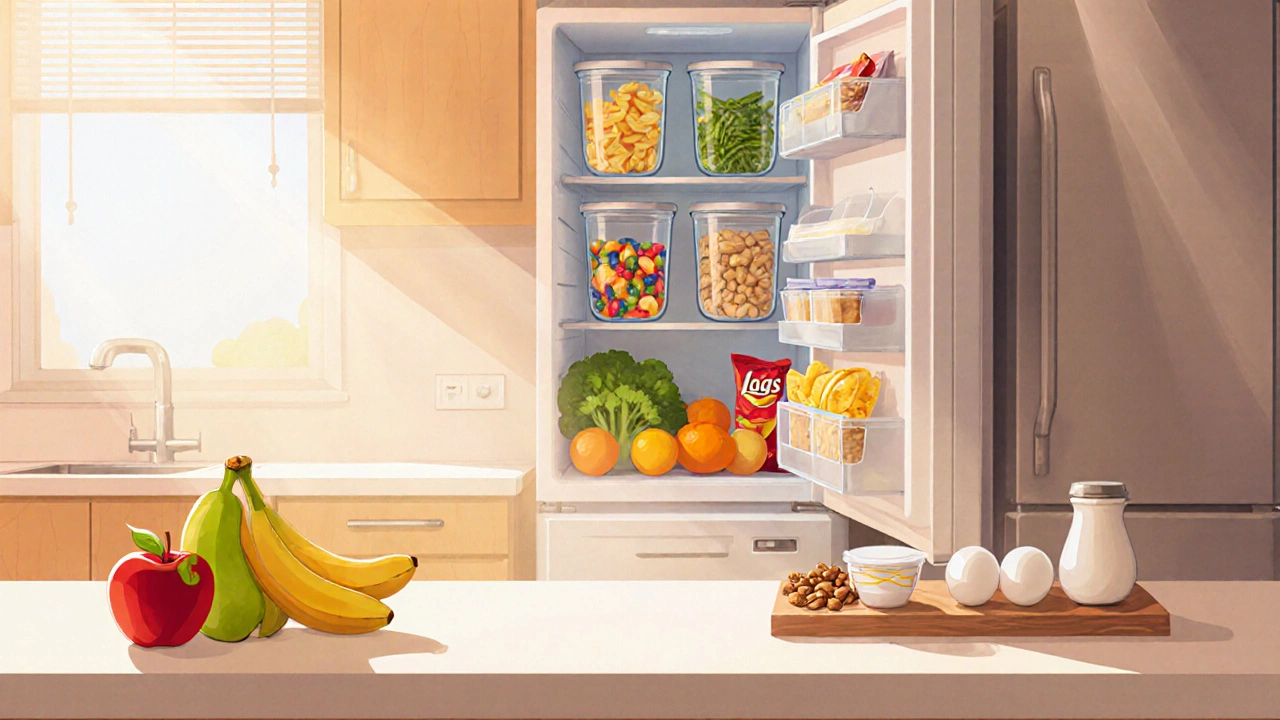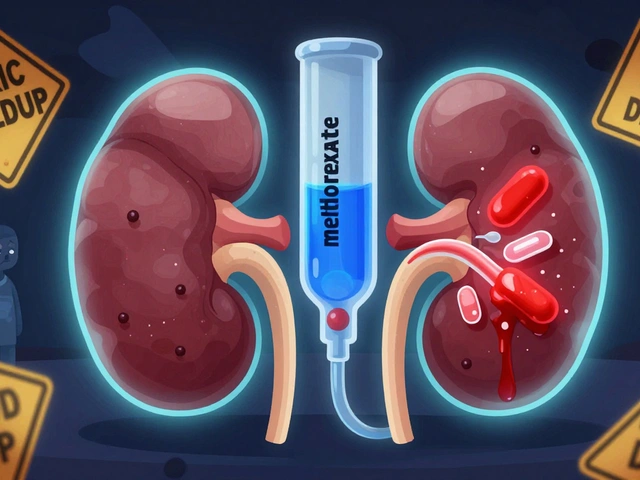
What Your Kitchen Is Telling You About Your Weight
The food you eat doesn’t just come from the grocery store or restaurant-it comes from your kitchen. Every time you open the fridge, walk past the counter, or grab a snack while watching TV, your environment is making choices for you. You don’t need willpower to eat better. You need a kitchen that makes healthy choices easy and unhealthy ones hard.
A 2021 NIH study found that people with a well-designed home food environment were 3.2 times more likely to eat enough fruits and vegetables and had 28% lower odds of being overweight. That’s not luck. That’s layout. That’s visibility. That’s how you set up your space.
Start with the Purge: Clear Out What Works Against You
Before you organize, you need to remove. This isn’t about being strict-it’s about removing temptation that doesn’t belong in your space. The Mayo Clinic recommends a 72-hour pantry purge. Go through every shelf, drawer, and cabinet. Take out anything that’s not whole food: chips, cookies, sugary cereals, soda, candy bars, processed snacks.
Don’t just move them to the back. Get rid of them. Donate unopened items if you can. Otherwise, throw them out. If you keep them around, even in a cupboard, your brain will still notice them. Research shows that simply removing visible unhealthy snacks reduces unplanned eating by 42%. That’s not a small win. That’s the foundation of everything else.
Don’t worry about wasting food. If you’ve had it for months and never eaten it, it wasn’t serving you. This step takes 1.5 to 2.7 hours for most homes. Set a timer. Do it on a weekend when you’re not rushed. You’ll feel lighter just by doing it.
Make Healthy Food the Default: Where to Put It
Now that the junk is gone, it’s time to make healthy food impossible to ignore. The science is clear: placement matters more than motivation.
- Put whole fruits-apples, bananas, oranges-on the counter at eye level. A 2023 analysis found this increases fruit consumption by 23%.
- In the fridge, store pre-cut veggies (carrots, bell peppers, celery) in clear containers at eye level. Prime Health MD’s clinical data shows this boosts vegetable intake by 17%.
- Keep a bowl of nuts or trail mix in a clear jar on the counter, pre-portioned into 1/4-cup servings. This cuts down on mindless eating.
- Store unhealthy foods on the top shelf, behind other items, or even in a different room. If you have to climb or walk across the kitchen to get them, you’re less likely to grab them.
UCSF Health’s guidelines say healthy snacks should be within 12 inches of your refrigerator door handle. That’s where your hand goes first. Make sure it lands on something good.
Build a Snack Station: No More Guesswork
One of the biggest reasons people snack late at night isn’t hunger-it’s decision fatigue. You’re tired. You’re bored. You open the fridge. And then… what? You stare. That’s when you grab the wrong thing.
Create a snack station: a dedicated shelf or drawer with pre-portioned, ready-to-eat healthy options. Think:
- 1/2 cup berries in a small container
- 1/4 cup almonds in a jar
- Hard-boiled eggs (peeled and ready)
- Greek yogurt cups
- Apple slices with a small tub of almond butter
Truemade’s 2023 study found that people who used this setup saved 2.4 hours a week on meal decisions and reduced food waste by 18%. It also cut evening snacking by an average of 327 calories per day. That’s nearly a full meal’s worth of calories gone-without counting a single one.
Spending 28 minutes once a week prepping this station is all it takes. Do it on Sunday. Label containers if it helps. Make it look inviting.

Change the Rules: Eat Only at the Table
Where you eat matters as much as what you eat. The NIH study found that eating while watching TV increased the odds of being overweight by 47%. Why? Because when you’re distracted, you don’t register fullness. You keep eating until the show ends.
UCSF Health’s 2023 guidelines are simple: Eat only while sitting down at the kitchen or dining room table. No eating while standing at the fridge. No eating while scrolling on your phone. No eating in front of the TV. No eating at your desk.
Start by removing the TV from the dining area. If you can’t, then make a rule: no meals with screens. This doesn’t mean you can’t watch TV at all-it means meals are sacred. They’re time to slow down, taste your food, and listen to your body.
People who follow this rule report feeling more satisfied after meals and eating less overall. It’s not about restriction. It’s about awareness.
Shop Smarter: What You Bring Home Sets the Tone
Your kitchen is only as healthy as the groceries you bring in. A 2021 NIH study found that shopping for fruit more frequently had the second-strongest link to better diet quality-after food placement.
Plan your shopping around what you’ll actually eat. Instead of buying a big bag of apples that might rot, buy one or two at a time. Buy veggies that are already washed and chopped if you’re short on time. Buy frozen berries-they’re just as nutritious, last longer, and are easier to use.
Make a rule: never shop hungry. And never buy snacks on impulse. Stick to your list. If you don’t need it, don’t bring it home. You can’t organize what you don’t have.
Involve the Household: It’s Not Just Your Kitchen
If you live with others, this isn’t just your project-it’s a team effort. The biggest challenge? Getting everyone on board. A 2022 survey found that 34% of people struggled to change habits when others in the home still ate unhealthy foods.
Here’s how to make it work:
- Don’t force change. Ask for input. “What healthy snacks do you like?”
- Let people help prep the snack station. It gives them ownership.
- Keep one drawer or shelf for their favorite treats-but make it less visible. That way, they’re not deprived, but they’re not constantly tempted either.
- Have one family meal a week where everyone sits at the table without screens. Make it fun. Play music. Talk.
When people feel included, they’re more likely to stick with it. JM Nutrition’s 2023 data shows involving family members increases success rates by 57%.

Why This Works Better Than Dieting
Diets fail because they rely on willpower. Willpower is limited. Your environment is constant.
When you change your kitchen, you’re not fighting yourself every time you’re hungry. You’re making the right choice automatic. That’s why environmental changes have a 68% adherence rate after 12 months, compared to just 42% for dieting alone.
People who reorganized their kitchens lost weight without counting calories. They didn’t feel deprived. They just ate better because it was easier.
One woman in a Prime Health MD case study said: “I stopped buying chips. Now I always have cut carrots on the counter. I’ve lost 12 pounds in three months.” That’s not magic. That’s design.
What to Do If You Slip Up
Some days, you’ll grab the wrong snack. Some nights, you’ll eat in front of the TV. That’s normal. The goal isn’t perfection. It’s progress.
If you notice yourself reaching for junk, don’t beat yourself up. Just ask: “What’s making this easy?” Maybe the chips are back on the counter. Maybe you didn’t prep your veggies. Adjust. Reset. Don’t restart.
It takes 2 to 4 weeks for new habits to stick. Be patient. Keep your healthy foods visible. Keep the junk out of sight. Your brain will catch up.
Small Changes. Big Results.
You don’t need to overhaul your entire life. You just need to rearrange your kitchen.
Put fruit on the counter. Pre-cut veggies at eye level. Remove the TV from the dining area. Build a snack station. Eat at the table.
These aren’t diet rules. They’re environmental design choices. And they work-because they don’t ask you to be strong. They ask you to be smart.
Start with one change today. Then another tomorrow. In a month, you won’t recognize your kitchen. And you won’t recognize how easy it is to eat well.
How long does it take to see results from changing my food environment?
Most people notice changes in their eating habits within 2 to 4 weeks. Weight loss or maintenance results typically show up in 6 to 8 weeks, especially when combined with consistent meal prep and reduced snacking. The key is consistency-not speed.
Do I need to buy special containers or gadgets?
No. Clear glass or plastic containers you already own work fine. The goal isn’t to spend money-it’s to make healthy food visible and easy to reach. Pre-portioning snacks into containers helps, but even using a bowl or plate on the counter can make a difference.
What if my family won’t cooperate with the changes?
Start small. Don’t demand a full kitchen overhaul. Just make one change that benefits everyone-like putting fruit on the counter or removing the TV from the dining area. Involve them in choosing healthy snacks. When people help decide, they’re more likely to follow through. You don’t need everyone to change overnight-just enough to make the environment supportive.
Can I still have treats in my kitchen?
Yes-but keep them out of sight. Store them in a high cabinet or a separate drawer, not on the counter or at eye level. The goal isn’t to ban treats, but to make them a conscious choice, not an automatic one. This reduces mindless eating while still allowing enjoyment.
Is this approach effective for long-term weight maintenance?
Yes. Research shows environmental changes have a 68% adherence rate after 12 months, compared to 42% for dieting alone. Because this method doesn’t rely on willpower, it’s sustainable. People who reorganize their kitchens are more likely to keep weight off long-term because the system supports them, not against them.






11 Comments